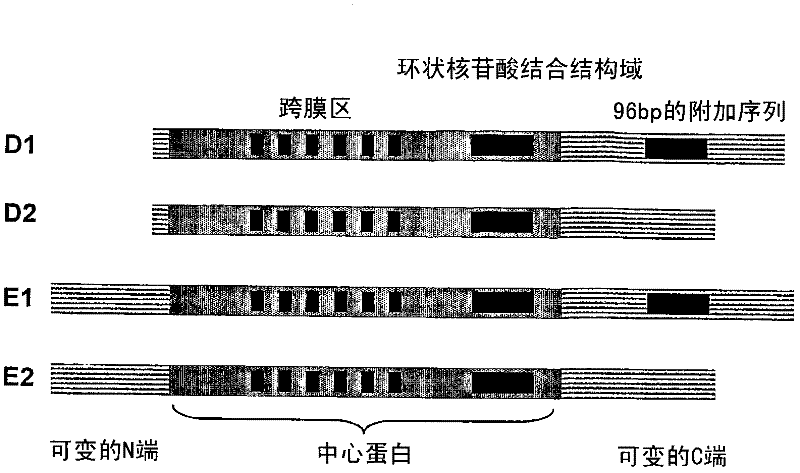Agent that modulates physiological condition of pests, involved in insect voltage-gated potassium channel activity
A technology of potassium channel and insecticidal activity, applied in the field of reagents involved in insect voltage-gated potassium channel activity to regulate the physiological status of pests, and can solve problems such as neuromuscular defects, gain-of-function mutations, movement and oviposition defects, etc.
- Summary
- Abstract
- Description
- Claims
- Application Information
AI Technical Summary
Problems solved by technology
Method used
Image
Examples
Embodiment 1
[0421] Example 1 (total RNA is extracted from cotton aphid and German cockroach)
[0422] (1) Extract total RNA from cotton aphid
[0423] Adults and larvae of a colony of cotton aphids (Aphis gossypii) cultivated on leaves of potted cucumbers were scraped from the leaf surfaces with a small brush, and 630 mg of the resulting colonies were pressed into powder with a mortar and pestle in liquid nitrogen. From the obtained freeze-crushed powder, RNA was isolated using RNA extraction reagent ISOGEN (manufactured by Nippon Gene) according to the following. After adding 10 ml of ISOGEN to the frozen crushed powder in the mortar, the crushed powder was kept on ice for 10 minutes for grinding. After milling, the fluid sample was transferred to a 15 ml test tube with a pipette, and 2 ml of chloroform (manufactured by Wako Pure Chemical Industries, Ltd.) was added thereto. The mixture was immediately shaken vigorously for 15 seconds, then allowed to stand at room temperature for 3 mi...
Embodiment 2
[0426] Embodiment 2 (isolation cotton aphid seizure gene)
[0427] Using total RNA from cotton aphids, random primers for RT-PCR (Invitrogen) and Superscript III (Invitrogen), first-strand cDNA was prepared according to the manufacturer's protocol of Superscript III.
[0428] By using an oligonucleotide comprising the nucleotide sequence of SEQ ID NO: 11 and an oligonucleotide comprising the nucleotide sequence of SEQ ID NO: 12, which are primers specific to the gene, and extending the long template PCR The system (manufactured by Roche) performs PCR according to the manufacturer's method to amplify the full-length cDNA of cotton aphid seizure. The cDNA described in Example 1 was used as a template. The PCR conditions used were those for descending PCR, as follows: initial denaturation at 94° C. for 2 minutes; then 10 descending-PCR cycles, one cycle being 94° C. for 30 seconds, and 70° C. for 30 seconds (each cycle decreased by 1 °C), and 68 °C for 4 minutes; followed by 25...
Embodiment 3
[0429] Embodiment 3 (separate german cockroach seizure gene)
[0430] In order to isolate homologues of the seizure gene from other insect species such as the German cockroach (Blatella germanica), the Codehop program (Blocks Protein Analysis Server (Blocks Protein Analysis Server) run by the Fred Hutchinson Cancer Research Center) was applied. website http: / / blocks.fhcrc.org / blocks / codehop.html), and with reference to the amino acid sequence of the aforementioned cotton aphid seizure and previously known amino acid sequences from humans such as (NCBI accession numbers Q12809 and Q9H252 ), Caenorhabditis elegans (NP_49782), Drosophila melanogaster (AAM68296), and Anopheles gambiae (XP_308166) homologue amino acid sequences, and degenerate primers were designed.
[0431] A partial sequence of a homologue of the seizure gene of a selected insect species is amplified by a series of PCRs using the first-strand cDNA derived from the insect species as a template. Here, the first-st...
PUM
 Login to View More
Login to View More Abstract
Description
Claims
Application Information
 Login to View More
Login to View More - Generate Ideas
- Intellectual Property
- Life Sciences
- Materials
- Tech Scout
- Unparalleled Data Quality
- Higher Quality Content
- 60% Fewer Hallucinations
Browse by: Latest US Patents, China's latest patents, Technical Efficacy Thesaurus, Application Domain, Technology Topic, Popular Technical Reports.
© 2025 PatSnap. All rights reserved.Legal|Privacy policy|Modern Slavery Act Transparency Statement|Sitemap|About US| Contact US: help@patsnap.com



